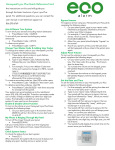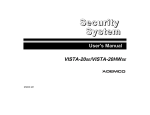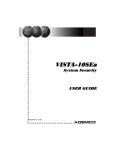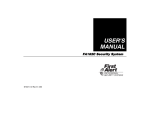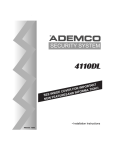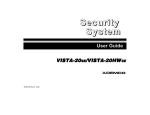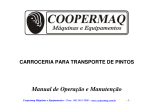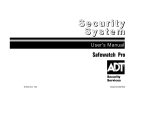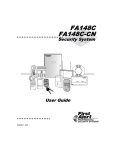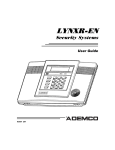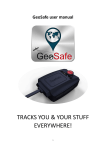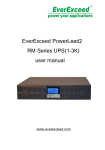Download Vista 20SEa User Manual (Australian)
Transcript
www.PDF-Zoo.com
®
TABLE OF CONTENTS
PANIC KEYS ............................................................... 22
USING DEVICE COMMANDS ..................................... 23
COMMON AREA OPERATION ................................... 24
SECURITY CODES ..................................................... 25
General .................................................................... 25
Babysitter Code ....................................................... 25
Duress Code............................................................ 25
Quick Arming ........................................................... 25
To Add or Change A User’s Code ........................... 26
To Delete A User ..................................................... 26
TESTING THE SYSTEM.............................................. 27
TROUBLE CONDITIONS ............................................ 29
FIRE ALARM SYSTEM (IF INSTALLED) .................... 31
MAINTAINING YOUR SYSTEM .................................. 32
QUICK GUIDE TO SYSTEM FUNCTIONS.................. 34
SUMMARY OF AUDIBLE NOTIFICATIONS............... 36
Alpha Keypads......................................................... 36
Fixed-Word Keypads ............................................... 37
GLOSSARY ................................................................. 38
PROTECTION ZONES LIST........................................ 39
LIMITATIONS STATEMENT ....................................... 40
INDEX .......................................................................... 42
LIMITED WARRANTY ................................................. 43
– 2–
www.PDF-Zoo.com
SYSTEM OVERVIEW .................................................... 3
General ...................................................................... 3
A Partitioned System ................................................. 3
Zones ........................................................................ 3
Burglary Protection ................................................... 4
Security Codes .......................................................... 4
Fire Protection ........................................................... 5
Alarms ....................................................................... 5
Memory of Alarm ....................................................... 5
Phone Access & Voice Response ............................. 5
ENTRY/EXIT DELAYS .................................................. 6
General Information................................................... 6
ABOUT THE KEYPADS ................................................ 7
FUNCTIONS OF THE KEYPADS ................................ 10
CHECKING FOR OPEN ZONES ................................. 12
ARMING PERIMETER ONLY (STAY)......................... 13
ARMING PERIMETER ONLY (INSTANT) ................... 14
ARMING ALL PROTECTION (AWAY)........................ 15
ARMING ALL PROTECTION (MAXIMUM) ................. 16
DISARMING AND SILENCING ALARMS ................... 17
Memory of Alarm ..................................................... 18
BYPASSING PROTECTION ZONES .......................... 19
Displaying Bypassed Zones .................................... 20
CHIME MODE .............................................................. 21
SYSTEM OVERVIEW
General
Congratulations on your ownership of an Ademco Partitioned Security System. You've made a
wise decision in choosing it, for it represents the latest in security protection technology today.
Ademco is the world's largest manufacturer of security systems and millions of premises are
protected by Ademco systems.
This system offers you three forms of protection: burglary, fire and emergency. Your system
consists of at least one keypad which provides control of system operation, and includes
various sensors which provide perimeter and interior burglary protection, plus smoke or
combustion detectors designed to provide early warning in case of fire .
The system uses microcomputer technology to monitor all protection zones and system status
and provides appropriate information for display on the keypad(s) used with the system, and
initiates appropriate alarms. Your system may also have been programmed to automatically
transmit alarm or status messages over the phone lines to a central alarm monitoring station.
A Partitioned
System
Simply stated, a partitioned system provides two or more separate areas of protection intended
for use by independent users. For the most part, you need not know about other partition users
and their structure in the system, but from time to time, you may see display messages which
indicate the system is in use by a user in another partition. This is normal.
A partitioned system may also have a “common” area, which is an area shared by users of both
independent partitions in this system. This common area can be regarded as a third partition.
Refer to the COMMON AREA OPERATION section for details.
Zones
Your system's sensing devices have been assigned to various "zones." For example, the
sensing device on your Entry/Exit door may have been assigned to zone 01, sensing devices
on windows in the master bedroom to zone 02, and so on. These numbers will appear on the
display, along with a description for that zone (if programmed), when an alarm or trouble
condition occurs.
www.PDF-Zoo.com
– 3–
SYSTEM OVERVIEW
Burglary Protection
Your system provides four modes of burglary protection: STAY, AWAY, INSTANT and
MAXIMUM, and allows you to BYPASS selected zones while leaving the rest of the system
armed. You must turn on or "arm" the burglary protection portion of your system before it will
sense burglary alarms. The system also provides a CHIME mode, for alerting users to the
opening of protected doors and windows while the system is disarmed. Refer to the other
sections of this manual for procedures for using these features.
The following table lists the four different arming modes and the results of each.
Arming
Mode
AWAY
STAY
INSTANT
MAXIMUM
Yes
Yes
Yes
Yes
Features For Each Arming Mode
Entry Delay
Perimeter Armed
Interior Armed
Yes
Yes
No
No
Yes
Yes
Yes
Yes
Yes
No
No
Yes
At the time of installation, you were assigned a personal four-digit security code, known only to
you. You must enter the security code when arming and disarming the system, and when
performing other system functions. As an additional safety feature, other users who do not have
a need to know your code can be assigned different security codes. Refer to the SECURITY
CODES section for procedures on adding security codes to the system.
– 4–
www.PDF-Zoo.com
Security Codes
Exit Delay
SYSTEM OVERVIEW
Fire Protection
The fire protection portion of your security system (if used) is always active and will sound an
alarm if a fire condition is detected. Refer to the FIRE ALARM SYSTEM section for important
information concerning fire protection, smoke detectors and planning emergency exit routes
from the premises.
Alarms
When an alarm occurs, both the keypad and external sounders will sound, and the keypad will
display the zone(s) causing the alarm. If your system is connected to a central monitoring
station, an alarm message will also be sent. To stop the alarm sounding, simply disarm the
system.
Memory of Alarm
When an alarm condition occurs, the keypad displays the number(s) of the zone(s) that caused
the problem, and displays the type of alarm (ex. FIRE, ALARM). It remains displayed until it is
cleared by disarming the system (see DISARMING THE SYSTEM section).
Phone Access &
Voice Response
Capability
Your system may include a voice module that will permit you to access the system via a TouchTone phone, either on-premises or by call-in when away. The phone access feature will enable
you to do the following:
• Receive synthesised voice messages over the telephone regarding the status of the security
system.
• Arm and disarm the system and perform most function commands via the telephone, with
voice confirmation provided after each command entry.
Complete information regarding the use of this feature is provided in a separate manual entitled
PHONE ACCESS USER'S GUIDE, which accompanies the voice module.
www.PDF-Zoo.com
– 5–
ENTRY/EXIT DELAYS
Your system has preset time delays, known as exit delay and entry delay. Whenever you arm
your system, exit delay gives you time to leave through the designated exit door without setting
off an alarm. Exit delay begins immediately after entering any arming command, and applies to
all modes of arming protection. If programmed, a slow beeping will sound throughout the exit
delay period.
Entry Delays give you time to disarm the system when you re-enter through the designated
entrance door. But you must disarm the system before the entry delay period ends, or an alarm
will occur. The keypad beeps during the entry delay period, reminding you to disarm the
system. There are two entry delays (if programmed). The first is for your primary entrance and
the second can be used for a secondary entrance, where a longer delay is required to walk to
the keypad to disarm the system.
You can also arm the system with no entry delay at all by using either INSTANT or MAXIMUM
arming modes. These modes provide greater security while on the premises or while away for
extended periods of time.
See your installer for your delay times.
Partition 1
Partition 2
Exit Delay:
Exit Delay:
seconds
seconds
Entry Delay 1:
seconds
Entry Delay 2:
seconds
Entry Delay 1:
seconds
Entry Delay 2:
seconds
– 6–
www.PDF-Zoo.com
General Information
ABOUT THE KEYPADS
IMPORTANT: If the key pad beeps rapidly upon
entering the premises, it
indicates that an alarm
has oc curred during
your ab sence and an
intruder may still be on
the premises. LEAVE
IMMEDIATELY and
CONTACT THE POLICE
from a nearby safe
location.
Your keypads allow you to control all system functions. The keypads feature a telephone
style (digital) keypad and a Liquid Crystal Display (LCD) which shows the nature and location
of all occurrences.
The keypads also feature a built-in sounder which will sound during alarms and troubles. The
keypads also "beep" during certain system functions, such as during entry/exit delay times, in
CHIME mode, and when depressing any of the keys (to acknowledge the key press).
There are two basic types of keypads – a Fixed-Word keypad and an Alpha keypad (both
described below).
2-Line Alpha Keypad
2-line Alpha keypads feature a 2-line, 32-character alphanumeric LCD which can display
system messages in friendly English. These keypads can also be programmed with custom
zone descriptors. The screen displays depicted throughout this manual are those that
would typically appear on a 2-line Alpha keypad.
Fixed-Word Keypad
Fixed-Word keypads are functionally identical to Alpha keypads, but the LCD display uses
pre-designated words to identify the nature and location of occurrences.
– 7–
www.PDF-Zoo.com
General
ARMED
READY
1
2
3
OFF
AWAY
STAY
4
5
6
MAX
TEST
BYPASS
7
8
9
INSTANT
CODE
CHIME
*
0
#
READY
PANIC
6139 ALPHA KEYPAD
AWAY
NO AC
STAY
CHIME
BAT
ALARM INSTANT
CHECK BYPASS
NOT READY
FIRE
AWAY
ARMED
NO AC
READY
BAT
A
1
2
3
OFF
AWAY
STAY
4
5
6
MAX
TEST
BYPASS
7
8
9
INSTANT
CODE
CHIME
*
0
#
ARMED
BYPASS NOT READY
ALARM STAY CHIME
FIRE CHECK INSTANT
B
C
READY
1
2
3
OFF
AWAY
STAY
4
5
6
MAX
TEST
BYPASS
7
8
9
INSTANT
CODE
CHIME
0
#
*
READY
READY
PANIC
PANIC
6128
6137
FIXED-WORD KEYPADS
www.PDF-Zoo.com
– 8–
ABOUT THE KEYPADS
Fixed-Word Keypad Displays
AWAY: All burglary zones, interior and perimeter, are armed.
STAY: Perimeter burglary zones, such as protected windows
and doors, are armed.
00
00
INSTANT: Perimeter burglary zones armed and entry delay is
turned off.
ALARM
CHECK
FIRE
BYPASS: One or more burglary protection zones have been
bypassed.
NOT READY: Appears when burglary portion of the system has open
protection zones.
READY: All burglary system zones are secure.
NO AC: Appears when AC mains has been cut off. System is
operating on backup battery power.
AWAY
STAY
INSTANT
BYPASS
NO AC
CHIME
BAT
NOT READY
6128 DISPLAY
00
00
AWAY
NO AC
BYPASS NOT READY
ALARM
ALARM STAY CHIME
FIRE
FIRE CHECK INSTANT
BAT
6137 DISPLAY
AC: Appears when AC mains is present.
CHIME: Appears when the CHIME feature is activated.
BAT: Low battery condition in a wireless sensor (if zone
number displayed) or low system battery (if no zone number displayed).
ALARM: Appears when an intrusion has been detected and the system is armed (also appears during a fire
alarm or audible emergency alarm). Accompanied by the protection zone in alarm.
CHECK: Appears when a malfunction is discovered in the system at any time or if an open is detected in a FIRE
zone at any time or a fault in a DAY/NIGHT burglary zone during a disarmed period. Accompanied by a
display of zone number in trouble.
FIRE: Appears when a fire alarm is present. Accompanied by a display of the zone in alarm.
www.PDF-Zoo.com
– 9–
FUNCTIONS OF THE KEYPADS
DISPLAY WINDOW: Shown on next page, a 2-line, Liquid
Crystal Display (LCD). Fixed-word keypads are functionally
similar but use pre-designated words in their displays. Both
types display protection point identification and system
status messages.
2.
OFF KEY: Disarms the burglary portion of the system,
silences alarms and audible trouble indicators, and clears
visual alarm trouble after the problem has been corrected.
3.
AWAY KEY: Completely arms both perimeter and interior
burglary protection for backup protection by sensing an
intruder's movements through protected interior areas as
well as guarding protected doors, windows, etc. Entrance
can be made through an entry delay zone without causing
an alarm if the system is disarmed before the entry delay
time expires.
4.
5.
STAY KEY: Arms the perimeter burglary protection,
guarding protected doors, windows and other perimeter
protection points, and sounds an alarm if one is opened.
Interior protection is not armed, which allows movement
within your house without causing an alarm. Entrance can
be made through an entry delay zone without causing an
alarm if the system is disarmed before the entry delay time
expires.
MAXIMUM KEY: Arms in manner similar to AWAY mode,
but eliminates the entry delay period, thus providing
maximum protection. An alarm will occur immediately upon
opening any protection point, including entry delay zones.
6.
TEST KEY: Tests the system and alarm sounder.
7.
BYPASS KEY: Removes individual protection zones
from being monitored by the system. Displays currently
bypassed protection zones.
8.
INSTANT KEY: Arms in manner similar to STAY mode,
but turns off the entry delay period, offering greater security
while inside and not expecting any late arrivals. An alarm
will occur immediately upon opening any perimeter
protection point, including entry delay zones
9.
CODE KEY: Allows the entry of additional user codes
that can be given to other users of the system.
10.
CHIME KEY: Turns the CHIME mode on and off. When
on, any entry through a protected delay or perimeter zone
while the system is disarmed will cause a tone to sound at
the Keypad(s).
11.
READY KEY: When depressed prior to arming the
system, the keypad will display all open protection zones
within the keypad's home partition.
12.
#
KEY: Permits ARMING of the system without use
of a security code ("Quick Arm", if programmed). Also used
to view the second line of single-line Alpha keypads.
13.
KEYS 0–9: Used to enter your individual security access
code(s).
– 10 –
www.PDF-Zoo.com
1.
1
R E A D Y INDICATOR: (GREEN) The
system has no open zones if lit, while
unlit indicates the system has open
zones.
2
5
3
15. ARMED INDICATOR: (RED) Lit when
the system has been armed (STAY,
AWAY, INSTANT or MAXIMUM).
16. I N T E R N A L SOUNDER: Source of
audible internal warning and confirmation
sounds, as well as alarms (see
"Summary of Audible Notifications").
17. A-B-C PANIC KEYS: Some keypads
use key pairs to activate panic alarms,
rather than individual keys. Refer to the
PANIC KEYS section for descriptions of
these keys.
4
6
ARMED
READY
A
15
A
14
B
B
C
C
16
D
OFF
OFF
AWAY
AWAY
STAY
1
2
3
3
MAX
MAX
TEST
TEST
BYPASS
4
5
5
6
6
INSTANT
INSTANT
CODE
CHIME
CHIME
7
7
8
9
9
0
0
#
#
17
8
9
10
READY
READY
*
*
IMPORTANT!:
When you use the keypad to enter codes
and commands, press the keys within 2
seconds of one another. If 2 seconds
elapse without a key depression, the entry
is aborted and must be repeated from its
beginning.
7
PANIC
11
12
13
SHOWN WITH KEYPAD COVER REMOVED
TYPICAL ALPHA KEYPAD
Fixed-Word Keypads are functionally similar,
except for screen displays.
– 11 –
www.PDF-Zoo.com
14.
CHECKING FOR OPEN ZONES
Before arming your system, all protected doors, windows and other protection zones not on the
exit route must be closed or bypassed (see BYPASSING section). Otherwise the keypad will
display a "Not Ready" message.
Note: A green READY indicator on the keypad will be lit if all protection zones in the system
are secure. If not lit, the system can only be armed if the zones that are NOT READY are on
the exit route.
DISARMED - PRESS ✱
TO SHOW FAULTS
Using the READY key will display all zones that are faulted,
making it easier for you to secure any open zones.
To show faulted zones:
READY
1.
2.
3.
✱
PRESS THE READY KEY
Do not enter security code, but simply press the READY key.
F AULT 05 F RONT
UPST AIRS BE DROOM
SECURE FAULTED ZONES
Typical fault display shows open zones. Secure or bypass the
non-exit route zones displayed before arming the system.
DISARME D ✱ ✱ ✱
RE ADY T O ARM
SYSTEM CAN BE ARMED
The "Ready" message will be displayed when all protection
zones have been either closed or bypassed.
You may now arm the system as usual if the zones that are NOT
READY are on the exit routes.
✱✱✱
– 12 –
www.PDF-Zoo.com
Using the ✱
READY Key
ARMING PERIMETER ONLY
(With Entry Delay ON)
NOTE:
Failure to close an
open exit route zone
before the exit delay
time ends may result in
that zone being automatically bypassed at
that time
Use this key when you are staying home, but might expect someone to use the entrance door
later.
When armed in STAY mode, the system will sound an alarm if a protected door or window is
opened, but you may otherwise move freely throughout the premises. Late arrivals can enter
through the entrance door without causing an alarm, but they must disarm the system within the
entry delay period or an alarm will occur.
Close all protected perimeter windows and non-main exit doors before arming (see
CHECKING FOR OPEN ZONES section).
STAY
+
1.
2.
3
ENTER SECURITY CODE THEN PRESS STAY
(Security Code)
Example: 7
ARME D ✱ ✱ ✱ S T AY ✱ ✱ ✱
LISTEN FOR 3 BEEPS
The keypad will beep three times and will display the armed
STAY message. The red ARMED indicator also lights.
2
9
6
then press the STAY key.
You can restart the exit delay at any time after arming in the STAY mode by pressing the ✱
key. This is useful if you wish to open the entry/exit door to let someone in after arming the
system. This avoids having to disarm the system and then arm it again.
– 13 –
www.PDF-Zoo.com
Using the
3
STAY key
ARMING PERIMETER ONLY
(With Entry Delay OFF)
Note:
Failure to close an
open exit route zone
before the exit delay
time ends may result in
that zone being automatically bypassed at
that time
Use this key when you are staying home and do not expect anyone to use the entrance door.
When armed in INSTANT mode, the system will sound an alarm if a protected door or window
is opened, but you may otherwise move freely throughout the premises. The alarm will also
sound immediately if anyone opens the entrance door.
Close all protected perimeter windows and non-main exit doors before arming (see
CHECKING FOR OPEN ZONES section).
INSTANT
+
1.
7
(Security Code)
2.
ARME D ✱ INST ANT
ENTER SECURITY CODE THEN PRESS INSTANT
Example: 7
✱
2
9
6
then press the INSTANT key .
LISTEN FOR 3 BEEPS
The keypad will beep three times and will display the armed
INSTANT message. The red ARMED indicator also lights.
You can restart the exit delay at any time after arming in the INSTANT mode by pressing the
✱ key. This is useful if you wish to open the entry/exit door to let someone in after arming
the system. This avoids having to disarm the system and then arm it again.
– 14 –
www.PDF-Zoo.com
Using the
7
INSTANT Key
ARMING ALL PROTECTION
(With Entry Delay ON)
NOTE:
Failure to close an
open exit route zone
before the exit delay
time ends may result in
that zone being automatically bypassed at
that time
Use this key when no one will be staying on the premises.
When armed in AWAY mode, the system will sound an alarm if a protected door or window is
opened, or if any movement is detected inside the premises. You may leave through the
entrance door during the exit delay period without causing an alarm. You may also re-enter
through the entrance door, but must disarm the system within the entry delay period or an alarm
will occur.
Close all protected perimeter windows and non-main exit doors before arming (see
CHECKING FOR OPEN ZONES section).
AWAY
+
1.
(Security Code)
2.
ARME D ✱ ✱ AWAY ✱ ✱
YOU MAY E XIT NOW
2
ENTER SECURITY CODE THEN PRESS AWAY
Example: 7
2
9
6
then press the AWAY key.
LISTEN
The keypad will beep twice, or beep continuously if exit
warning has been programmed for your system, and
displays the armed AWAY message. The red ARMED
indicator also lights.
The "You May Exit Now" portion of the message disappears
when the exit delay expires.
– 15 –
www.PDF-Zoo.com
Using the
2
AWAY Key
ARMING ALL PROTECTION
(With Entry Delay OFF)
NOTE:
Failure to close an
open exit route zone
before the exit delay
time ends may result in
that zone being automatically bypassed at
that time
Use this key when the premises will be vacant for extended periods of time such as vacations,
etc., or when no one will be moving through protected interior areas.
When armed in MAXIMUM mode, the system will sound an alarm if a protected door or window
is opened, or if any movement is detected inside the premises. You may leave through the
entrance door during the exit delay period without causing an alarm, but an alarm will be
sounded as soon as someone re-enters.
Close all protected perimeter windows and non-main exit doors before arming (see
CHECKING FOR OPEN ZONES section).
MAXIMUM
+
1.
(Security Code)
2.
ARME D ✱ MAXIMUM ✱
YOU MAY E XIT NOW
4
ENTER SECURITY CODE THEN PRESS MAXIMUM
Example: 7
2
9
6
then press the MAXIMUM key.
LISTEN
The keypad will beep twice, or beep continuously if exit
warning has been programmed for your system, and will
display the armed MAXIMUM message (AWAY/INSTANT on
fixed-word keypads). The red ARMED indicator also lights.
The "You May Exit Now" portion of the message disappears
when the exit delay expires.
– 16 –
www.PDF-Zoo.com
Using the
4
MAXIMUM Key
DISARMING AND SILENCING ALARMS
Use the OFF key to disarm the system and to silence alarm and trouble sounds. See
"SUMMARY OF AUDIBLE NOTIFICATION" section for information which will help you to
distinguish between FIRE and BURGLARY alarm sounds.
IMPORTANT: If you return and the main burglary sounder is on, DO NOT enter the premises,
but call the police from a nearby safe location. If you return after an alarm has occurred and
the main sounder has shut itself off, the keypad will beep rapidly upon entering, indicating that
an alarm has occurred during your absence and an intruder may still be on the premises.
LEAVE IMMEDIATELY and CONTACT THE POLICE from a nearby safe location.
To disarm the system and silence burglary alarms:
OFF
+
1.
(Security Code)
2.
DISARME D ✱ ✱ ✱
RE ADY T O ARM
✱✱✱
1
ENTER SECURITY CODE, THEN PRESS OFF
Example: 7
2
9
6
then press the OFF key.
LISTEN FOR 1 BEEP
The “Ready” message will be displayed (if no alarms have
occurred while armed) and the keypad will beep once to
confirm that the system is disarmed.
– 17 –
www.PDF-Zoo.com
Using the
1
OFF Key
DISARMING AND SILENCING ALARMS
(Continued)
If an alarm occurs, the keypad displays the zone number (s) that caused the alarm and the type
of alarm. These messages remain displayed until cleared by a user.
To clear the display, note the zone number displayed and enter an OFF sequence (enter your
security code and press the OFF key).
If the “Ready” message will not display, go to the displayed zone and correct the fault (close
windows, etc.). If the fault cannot be corrected, notify your alarm company.
– 18 –
www.PDF-Zoo.com
Memory of Alarm
BYPASSING PROTECTION ZONES
This key is used when you want to arm your system with one or more zones intentionally
unprotected. Bypassed zones are unprotected and will not cause an alarm when violated while
your system is armed. All bypasses are removed when an OFF sequence (security code
plus OFF) is performed. Bypasses are also removed if the arming procedure that follows the
bypass command is not successful.
The system will not allow fire zones to be bypassed.
To bypass zones, the system must be disarmed first.
BYPASS
+
1.
6
(Security Code)
2.
3.
Example: 7
2
9
6
then press the BYPASS key.
ENTER ZONE NUMBERS
(Zone Numbers)
Enter the zone number(s) for the zones to be bypassed
(e.g., 01, 02, 03, etc.).
Important! All single-digit numbers must be preceded by a
zero (for example, enter 01 for zone 1).
BYPASS 07 F RONT
UPST AIRS BE DROOM
WAIT
The keypad will display the word BYPASS along with each
bypassed zone number. Wait for these zones to be
displayed, to be sure that intended zones are bypassed.
Typical bypass message
4.
ENTER SECURITY CODE THEN PRESS BYPASS
DISARME D BYPASS
RE ADY T O ARM
ARM AS USUAL
Arm the system as usual when the keypad displays the
"Ready ” message.
(Continued)
– 19 –
www.PDF-Zoo.com
Using the
6
BYPASS Key
BYPASSING PROTECTION ZONES (Continued)
For determining what zones have been previously bypassed. Bypassed zones can be displayed
only when the system is disarmed, and when the “Bypass” message shown in step 3 above is
displayed.
BYPASS
+
1.
2.
6
ENTER SECURITY CODE THEN PRESS BYPASS
(Security Code)
Example: 7
BYPASS 07 F RONT
UPST AIRS BE DROOM
WAIT
In a few moments, all open zones will be sequentially
displayed along with the word BYPASS.
Typical bypass message
2
9
6 then press the BYPASS key.
– 20 –
www.PDF-Zoo.com
Displaying
Bypassed Zones
CHIME MODE
† or selected doors or
windows if the chimeby-zone feature is
active. Ask your
installer if this feature
applies to your
system.
Your system can be set to alert you to the opening of a door or window † while it is disarmed by
using CHIME mode. When activated, three beeps will sound at the keypad whenever a
protected perimeter door or window is opened. Pressing the READY key will display the open
protection points.
Note that the Chime mode can be activated only when the system is disarmed.
To turn Chime Mode on:
CHIME
+
1.
9
(Security Code)
2.
ENTER SECURITY CODE THEN PRESS CHIME
Example: 7
2
9
6 then press the CHIME key.
VIEW
The “Chime” message displays while chime mode is on.
DISARME D C HIME
RE ADY T O ARM
To turn Chime Mode off:
CHIME
+
1.
(Security Code)
2.
DISARME D ✱ ✱ ✱
RE ADY T O ARM
✱✱✱
9
ENTER SECURITY CODE THEN PRESS CHIME
Example: 7
2
9
6 then press the CHIME key.
VIEW
The “Chime” message disappears from the display.
– 21 –
www.PDF-Zoo.com
Using the
9
CHIME Key
PANIC KEYS
(FOR MANUALLY ACTIVATING SILENT AND/OR AUDIBLE ALARMS)
Using
Panic Keys
Your installer
should note the
functions that
are active in
your system.
Your system may have been programmed to use special keys to manually activate panic
functions. The functions that might be programmed are listed below. See your installer for the
function(s) that may have been programmed for your system.
Active Panic Functions
Keys
Zone
Function
1 and ✱
95
3 and #
96
✱ and #
99
A*
95
B*
99
C*
96
* May not be present on your keypad(s).
To use a paired key panic function, simply press both keys of the assigned pair at the same
time. If your keypad has lettered keys for panic functions, press the designated key and hold
down for at least 2 seconds to activate the panic function.
* If your system is
connected to an
alarm monitoring
company.
A silent emergency sends an alarm signal
to the alarm monitoring company,* but there
will be no audible alarms or visual displays.
An audible emergency sends an
emergency message to the alarm monitoring
company* and sounds a loud, steady alarm
at your keypad and at any external sounders
that may be connected (ALARM plus a zone
number is also displayed).
A personal emergency alarm sends an
emergency message to the alarm monitoring
company* and sounds at keypads, but not at
external sounders. ( A L A R M plus a zone
number is also displayed)
A fire alarm sends a fire alarm message to
the alarm monitoring company* and uniquely
activates keypad and any external sounders
(FIRE plus a zone number is also displayed).
– 22 –
www.PDF-Zoo.com
Types of Panic
Alarms
USING DEVICE COMMANDS
General Information
To activate devices
Your system may be set up so that certain lights or other devices can be turned on or off by
using the device command from the keypad. Ask your installer if this has been done in your
system. If programmed for your system, some devices may activate automatically upon certain
system conditions. In this case, the following commands can be used to override the device
activation. See your installer for a full explanation of this feature.
ENTER SECURITY CODE THEN PRESS # + 7 + DEVICE NUMBER
+
#
(Security Code)
+7 +
(Device Number)
Example: 7
2
9
6 then press # , then press 7 , then enter the number
representing the device you wish to activate. See your installer for device numbers assigned
for your system.
ENTER SECURITY CODE THEN PRESS # + 8 + DEVICE NUMBER
+
(Security Code)
#
+8 +
(Device Number)
Example: 7
2
9
6 then press # , then press 8 , then enter the number
representing the device you wish to deactivate. See your installer for device numbers assigned
for your system.
Device
1
2
3
4
Description
Device
5
6
7
8
Description
– 23 –
www.PDF-Zoo.com
To deactivate
devices
COMMON AREA OPERATION
Your system may have been set up to use a common area, which is an area shared by users of
both independent partitions, such as a foyer or lobby. This area is, in effect, a third partition. If
your system is set up for this, please note the following:
• The common area will sound and report alarms only when both partitions are armed. If only
one partition is armed, the system ignores faults on the common area.
• Either partition may arm its system if the common area is faulted, but once armed, the other
partition will not be able to arm unless the common area is first bypassed or the fault is
corrected.
• Faults on the common area are displayed on keypads in both partitions.
• Either partition can clear and restore the common area after an alarm.
Ask your installer if a common area was assigned. If so, place a check mark here.
www.PDF-Zoo.com
– 24 –
SECURITY CODES
General Information
As an additional safety feature, other users who do not have a need to know your code can be
assigned different security codes. These secondary users are identified by "user numbers,"
which are selected when assigning a user's security code. You can assign up 14 additional user
codes (user numbers 03-16), including the babysitter and duress codes. Note that the master
(primary) user of the system is the only one who can assign codes to secondary (or temporary)
users, and is user number 02; user number 01 is reserved for the installer of the system.
All codes can be used interchangeably when performing system functions (a system armed with
one user's code can be disarmed by another user's code), with the exception of the babysitter
code described below.
Babysitter Code This code can be used to arm the system in assigned partitions, but cannot disarm the system
unless the system was armed with this code. This code is typically assigned to someone (such
as a babysitter) who has a need to arm/disarm the system only at certain times. The babysitter
code is assigned to user 15. The user of this code should not use the “Quick Arming” feature
described below.
Duress Code
This feature is intended for use when you are forced to disarm or arm the system under threat.
When used, the system will act normally, but can silently notify the alarm monitoring company
of your situation, if that service has been provided. Duress code is assigned to user 16.
Important: This code is useful only when the system is connected to a alarm monitoring
company.
Quick Arming
Note that if "Quick Arming" was programmed by the installer, the # key can be pressed in
place of the security code when arming the system. The security code must always be used to
disarm the system, however.
www.PDF-Zoo.com
– 25 –
SECURITY CODES (Continued)
To Add a User or
Change a User's
Code
Changing the
Master Code
Follow the procedure for
changing a user’s code,
but enter user #02. You
will be prompted to enter
the new code a second
time to confirm
accuracy.
Important: Temporary users of the system (e.g., babysitters, cleaning staff, etc.) should not be
shown how to use any system function they do not need to know, such as bypassing protection
zones for example.
Sequential key depressions for all steps in a procedure must be made within 2 seconds of one
another, or else the entire entry is aborted and must be repeated from its beginning (e.g.,
perform steps 1, 2, and 3 below with no delay between steps).
CODE
+
1.
8
ENTER MASTER CODE THEN PRESS CODE KEY
(Master Code)
Example: 7
(User Number)
ENTER USER NUMBER
Enter the 2-digit User Number (03-16) for the user you
are adding or changing.
2.
3.
2
9
6 then press the CODE key.
ENTER USER'S CODE
Enter the new 4-digit security code for that user.
(User's Code)
CODE
+
1.
(Master Code)
2.
(User Number)
3.
STOP.
8
ENTER MASTER CODE THEN PRESS CODE KEY
Example: 7
2
9
6 then press the CODE key.
ENTER USER NUMBER
Enter the 2-digit User Number (03–16) for the user whose
code you are deleting.
Wait (about 3 seconds) until the keypad beeps once before
pressing any other key. The code is automatically deleted.
– 26 –
www.PDF-Zoo.com
To Delete a User
TESTING THE SYSTEM
(TO BE CONDUCTED WEEKLY)
The TEST key puts your system into the Test mode, which allows each protection point to be
checked for proper operation. The keypad sounds a single beep every 40 seconds as a
reminder that the system is in the Test mode.
Note: An alarm message will not be sent to be sent to your alarm monitoring company during
the following tests.
1.
DISARME D ✱ ✱ ✱
RE ADY T O ARM
✱✱✱
DISARM THE SYSTEM
Disarm the system and close all protected windows, doors, etc.
The “Ready” message should be displayed and the green
READY indicator should also be lit .
TEST
+
2.
(Security Code)
5
ENTER THE SECURITY CODE THEN PRESS TEST
Example:
7
2
9
6 then press the TEST key.
3. LISTEN.
The external sounder should sound for 1 second and then turn
off.
If the sounder does not sound, CALL FOR SERVICE
IMMEDIATELY.
4. FAULT ZONES.
Open each protected door and window in turn and listen for
three beeps from the keypad. Identification of each faulted
protection point should appear on the display. The display will
clear when the door or window is closed.
(Continued)
– 27 –
www.PDF-Zoo.com
Using the
5
TEST Key
TESTING THE SYSTEM (Continued)
Walk in front of any interior motion detectors (if used) and
listen for three beeps. The identification of the detector should
appear on the display when it is activated. The display will
clear when no motion is detected. Note that if wireless motion
detectors are used, there is a 3-minute delay between
activations. This is to conserve battery life.
To test all smoke detectors, follow the manufacturer's
instructions. The identification of each detector should appear
on the display when each is activated.
If a problem is experienced with any protection point (no
confirming sounds, no display), CALL FOR SERVICE
IMMEDIATELY.
When all protection points have been checked and are intact
(closed), there should be no zone identification numbers
displayed on the keypad.
When testing is completed, exit the TEST mode by continuing
with step 5.
OFF
(Security Code)
1
EXIT TEST MODE
Enter your security code and press the OFF key.
If the test mode is inadvertently left active, it automatically
turns off after 4 hours.
– 28 –
www.PDF-Zoo.com
+
5.
TROUBLE CONDITIONS
* Note that zone num -
The word CHECK on the Keypad's display, accompanied by a rapid " beeping" at the Keypad,
indicates that there is a trouble condition in the system. The displays in parenthesis may appear
on non-alpha keypads when the associated trouble condition is present.
To silence the beeping sound for "check" conditions, press any key.
1.
CHECK +
Zone
Descriptors
Indicates that a problem exists with those zone(s)*. First, determine if the
zone(s) displayed are intact and make them so if they are not. If the zone
the zone uses a wireless detector, check that changes in the room
(moving furniture, televisions, etc.) are not blocking wireless signals from
the detector. If the problem has been corrected, the zone descriptor(s)
and CHECK should disappear. If not, key an OFF sequence (security
code plus OFF) to clear the display. A CHECK condition can also indicate
a wiring problem. If the “check” display persists, CALL FOR SERVICE
IMMEDIATELY.
Note that the system will not allow arming if a CHECK condition exists. To
arm the system with a CHECK condition present, you must first bypass
the zone(s) having the CHECK condition.
2.
Telco Fault
(or CHECK
and zone 94)
If the telephone line monitor feature has been programmed for your
system, this display indicates that the telephone line has been
disconnected or cut. In some systems, this display will be accompanied by
a trouble sound from the keypad and the external sounder may be
activated. CONTACT YOUR SERVICE COMPANY IMMEDIATELY.
To silence the trouble sound, enter your security code plus OFF.
ber 9 represents a
problem with wireless
receivers or other
system devices, which
are not user serviceable. CALL FOR
SERVICE AT ONCE.
3.
COMM.
FAILURE
(or FC)
Indicates that a failure has occurred in the telephone communication
portion of your system. CALL FOR SERVICE IMMEDIATELY.
– 29 –
www.PDF-Zoo.com
Typical "Check"
Displays
TROUBLE CONDITIONS (Continued)
accompanies a low
battery display (items
4 and 5) can be
stopped by entering
an OFF sequence
(code + OFF)
** Not all systems use
wireless transmitters.
4.
SYSTEM LO BAT
(or BAT with no zone No.)
Indicates that a low system battery condition exists, and
accompanied by a once-per-minute "beeping"* at the
Keypad. CALL FOR SERVICE IMMEDIATELY.
5.
LO BAT + zone descriptor
(or BAT with zone No.)
Indicates that a low battery condition exists in the wireless
transmitter** displayed, and accompanied by a once-perminute "beeping"* at the Keypad. CALL FOR SERVICE.
6.
Rcvr Jam
(or CHECK 90)
Wireless part of the system is experiencing RF interference
which may impede reception from wireless sensors.**
7.
MODEM COMM
(or CC)
Indicates that the control is on-line with the central station’s
remote computer. The control will not operate while on-line.
Wait a few minutes. The display should disappear.
8.
AC LOSS is displayed
(or NO AC)
The system is operating on battery power only. If only some
lights are out on the premises, check circuit breakers and
fuses and reset or replace as necessary. CALL FOR
SERVICE if AC mains cannot be restored to the system.
9.
Busy-Standby (or dI)
If this remains displayed for more than 1 minute, system is
disabled. CALL FOR SERVICE AT ONCE.
10
OPEN CIRCUIT (or OC)
The keypad is not receiving signals from the control.
11.
Long Rng Trbl (or bF)
If programmed, back-up Alternative Media communication
has failed. CALL FOR SERVICE IMMEDIATELY.
12.
BELL FAILURE
(or CHECK 70)
Indicates that the wiring connection to the external sounder
is at fault (open or shorted). Accompanied by “beeping” at
the touchpad. CALL FOR SERVICE IMMEDIATELY.
– 30 –
www.PDF-Zoo.com
* T he beeping that
FIRE ALARM SYSTEM (IF INSTALLED)
Your fire alarm system (if installed) is active 24 hours a day, providing continuous protection. In
the event of an emergency, the installed smoke and heat detectors will automatically activate
your security system, triggering a loud, interrupted sound from the Keypad. An interrupted
sound will also be produced by optional exterior sounders. A FIRE message will appear at your
Keypad and remain on until you silence and clear the alarm display.
In Case Of Fire
1.
Silencing A Fire
Alarm
1.
Should you become aware of a fire emergency before your detectors sense the problem,
go to your nearest Keypad and press the single panic key (or panic key pair) assigned as
FIRE emergency (if programmed by the installer) and hold down for at least 2 seconds. The
alarm will sound.
2. Evacuate all occupants from the premises.
3. If flames and/or smoke are present, leave the premises and notify your local Fire Brigade
immediately.
4. If no flames or smoke are apparent, investigate the cause of the alarm. The zone descriptor
of the zone(s) in an alarm condition will appear at the Keypad.
Silence the alarm by pressing the OFF key. To clear the alarm display, enter your code and
press the OFF key again.
2. If the Keypad indicates a trouble condition after the second OFF sequence, check that
smoke detectors are not responding to smoke or heat producing objects in their vicinity.
Should this be the case, eliminate the source of heat or smoke.
3. If this does not remedy the problem, there may still be smoke in the detector. Clear it by
fanning the detector for about 30 seconds.
4. When the problem has been corrected, clear the display by entering your code and
pressing the OFF key.
– 31 –
www.PDF-Zoo.com
General
MAINTAINING YOUR SYSTEM
Taking Care of Your
System
The components of your security system are designed to be as maintenance-free as possible.
However, to make sure that your system is in reliable working condition:
1. Test your system weekly.
2. Test your system after any alarm occurs (see TESTING THE SYSTEM).
Replacing
Batteries in
Wireless Sensors
Each wireless sensor in your system has a 9-volt or 3-volt battery. The system detects a low
battery in any wireless sensor, including smoke detectors, the optional personal emergency
transmitter, and the optional portable wireless keypad. (A low battery in a portable wireless
keypad or keyfob is detected as soon as one of its keys is pressed, and the wired keypad will
display “00”.)
Alkaline batteries provide a minimum of 1 year of operation, and in most units and applications,
provide 2–4 years of service. 3-volt lithium batteries provide up to 4 or more years of operation.
Actual battery life will depend on the environment in which the sensor is used, the number of
signals that the transmitter in the sensor has had to send, and the specific type of sensor.
Factors such as humidity, high or low temperatures or large variations in temperature, may all
lead to the reduction of actual battery life in an installation.
If you have a low battery in a wireless sensor, a low battery message is displayed on the
keypad.
In addition, a battery-operated smoke detector with a low battery also emits a single "chirp"
sound approximately once every 20–30 seconds, identifying itself as the smoke detector with
the weak battery.
Note: The low battery message comes on as a warning that battery replacement in indicated
sensor(s) is due within 30 days. In the meantime, a sensor causing a low battery indication is
still fully operational.
Important: Use only batteries recommended by your installer as replacement.
– 32 –
www.PDF-Zoo.com
Wireless sensors
may not have been
used in your
security system
MAINTAINING YOUR SYSTEM (CONTINUED)
Silencing Low
Battery Warning
Tones at the Keypad
You can silence the keypad’s warning tones by pressing the OFF key, but the keypad's low
battery message display will remain on as a reminder that you have a low battery condition in
one or more of your sensors. When you replace the weak battery with a fresh one, the sensor
will send a "good battery" signal to the control as soon as the sensor is activated
(opening/closing of door, window, etc.), causing the low battery display to turn off. If the sensor
is not activated, the display will automatically clear within approximately 1 hour.
Routine Care • Treat the components of your security system as you would any other electrical equipment. Do
not slam sensor-protected doors or windows.
• Keep dust from accumulating on the keypad and all protective sensors, particularly on motion
sensors and smoke detectors.
• The keypad and sensors should be cleaned carefully with a dry soft cloth. Do not spray water
or any other fluid on the units.
www.PDF-Zoo.com
– 33 –
QUICK GUIDE TO SYSTEM FUNCTIONS
Function
Procedure
Comments
Check Zones
Press [✱]
Do this to view faulted zones when system not ready.
Arm System
Enter code
Press arming key desired
(AWAY, STAY, INSTANT,
MAXIMUM)
Do this to arm the system in the mode selected.
Disarm System
Enter code
Press OFF [1]
Do this to disarm the system and silence alarms.
Bypass zones
Enter code
Press BYPASS [6]
Enter zone numbers to be
bypassed (use 2-digit entries)
Do this to bypass protection zones. Bypassed zones are unprotected and will not cause an alarm if violated.
Chime Mode ON
Enter code
Press CHIME [9]
Enter code
Press CHIME [9]
Do this to turn on chime mode. Keypad will sound if (selected)
doors or windows are opened while system disarmed.
Do this to turn chime mode off.
Test Mode ON
Enter code
Press TEST [5]
Do this to enter test mode. Sounds alarm sounder and allows
sensors to be tested.
Test Mode OFF
Enter code
Press OFF [1]
Do this to turn test mode off. System returns to normal mode.
(Continued)
– 34 –
www.PDF-Zoo.com
Chime Mode OFF
QUICK GUIDE TO SYSTEM FUNCTIONS (Continued)
Function
Procedure
Comments
Add or Change
a User
Enter master code
Press CODE [8]
Enter user's 2-digit user No.
Enter code for that user
Do this to add or change a user code.
Delete a User
Enter master code
Press CODE [8]
Enter user number to be deleted
Wait until a beep is heard (approximately
3 seconds)
Do this to delete a user code from the system.
Change a Master
Code
Enter Master Code
Press CODE [8]
Press [0] + [2] Master User No.
Enter new 4-digit Master Code
Enter new Master Code again
Do this to change the existing Master Code.
www.PDF-Zoo.com
– 35 –
SUMMARY OF AUDIBLE NOTIFICATIONS
(ALPHA DISPLAY KEYPADS)
SOUND
CAUSE
DISPLAY
LOUD, INTERRUPTED
Keypad & External
LOUD, CONTINUOUS
Keypad & External
ONE SHORT BEEP
( not repeated)
Keypad only
FIRE ALARM
FIRE is displayed; descriptor of zone in alarm is displayed.
BURGLARY/AUDIBLE
EMERGENCY ALARM
a. SYSTEM DISARM
b. SYSTEM ARMING ATTEMPT
WITH AN OPEN NON-EXIT
ROUTE ZONE
c. BYPASS VERIFY
ALARM is displayed; descriptor of zone in alarm is also displayed.
RAPID BEEPING
Keypad only
SLOW BEEPING
Keypad only
a. SYSTEM IS IN TEST MODE
b. LOW BATTERY AT A
TRANSMITTER
ARM AWAY OR MAXIMUM
a. ARM STAY OR INSTANT
b. ZONE OPENED WHILE SYSTEM
IS IN CHIME MODE.
a. TROUBLE
b. MEMORY OF ALARM
c. SYSTEM LOW BATTERY
d. EXT. SOUNDER WIRING FAIL.
a. EXIT DELAY WARNING (if
programmed)
b. ENTRY DELAY WARNING
c. Numbers and descriptors of the bypassed protection zones are displayed
(One beep is heard for each zone displayed). Subsequently, the following is
displayed: DISARMED BYPASS/READY TO ARM
a. Opened Zone identifications will appear.
b. LO BAT displayed with description of transmitter.
ARMED AWAY or ARMED MAXIMUM is displayed. Red ARMED indicator is
lit.
a. ARMED STAY or ARMED INSTANT is displayed. Red ARMED indicator is
lit.
b. CHIME displayed, descriptor of open protection zone will be displayed if the
[✱] key is pressed.
a. CHECK displayed. Descriptor of troubled protection zone is displayed.
b. FIRE or ALARM is displayed; descriptor of zone in alarm is displayed.
c. SYSTEM LO BAT displayed .
d. BELL FAILURE is displayed.
a. ARMED AWAY or ARMED MAXIMUM is displayed along with You May
Exit Now
b. DISARM SYSTEM OR ALARM WILL OCCUR is displayed. Exceeding the
delay time without disarming causes alarm.
– 36 –
www.PDF-Zoo.com
ONE SHORT BEEP
(once every 40 seconds)
Keypad only
TWO SHORT BEEPS
Keypad only
THREE SHORT BEEPS
Keypad only
a. DISARMED/READY TO ARM is displayed.
b. The number and descriptor of the open protection zone is displayed.
SUMMARY OF AUDIBLE NOTIFICATIONS
(FIXED-WORD DISPLAY KEYPADS)
SOUND
CAUSE
DISPLAY
LOUD, INTERRUPTED
Keypad & External
LOUD, CONTINUOUS
Keypad & External
ONE SHORT BEEP
(not repeated)
Keypad only
FIRE ALARM
FIRE is displayed; zone number of zone in alarm is displayed.
BURGLARY/AUDIBLE
EMERGENCY ALARM
a. SYSTEM DISARM
b. SYSTEM ARMING ATTEMPT
WITH AN OPEN ZONE.
c. BYPASS VERIFY
ALARM is displayed; zone number of zone in alarm is also displayed.
ONE SHORT BEEP
(once every 40 seconds)
Keypad only
a. SYSTEM IS IN TEST MODE
b. LOW BATTERY AT A
TRANSMITTER
ARM AWAY OR MAXIMUM
RAPID BEEPING
Keypad only
SLOW BEEPING
Keypad only
c. Zone numbers of the bypassed protection zones are displayed (one beep is
heard for each zone displayed). Subsequently, the following is displayed:
BYPASS and READY
a. Opened zone numbers will appear.
b. BAT displayed with zone number of transmitter.
AWAY or AWAY & INSTANT is displayed. Red ARMED indicator is lit.
a. ARM STAY OR INSTANT
a. STAY or STAY INSTANT is displayed. Red ARMED indicator is lit.
b. ZONE OPENED WHILE SYSTEM
IS IN CHIME MODE.
a. TROUBLE
b. MEMORY OF ALARM
c. SYSTEM LOW BATTERY
d. EXT. SOUNDER WIRING FAIL.
a. EXIT DELAY WARNING (if
programmed)
b. ENTRY DELAY WARNING
b. CHIME displayed; zone number of open protection zone will be displayed if
the [✱] key is pressed.
a. CHECK displayed. Zone number of troubled protection zone is displayed.
b. FIRE or ALARM is displayed; zone number of zone in alarm is displayed
c. BAT displayed with no zone ID number.
d. CHECK 70 is displayed.
a. AWAY or AWAY & INSTANT is displayed.
b. Exceeding the entry delay time without disarming causes an alarm.
– 37 –
www.PDF-Zoo.com
TWO SHORT BEEPS
Keypad only
THREE SHORT BEEPS
Keypad only
a. READY is displayed.
b. The number of the open protection zone is displayed.
GLOSSARY
The following terms are used throughout the manual.
ARM/DISARM: "Armed" simply means that the burglary portion of your system is turned ON and is in a state of
readiness. "Disarmed" means that the burglary system is turned OFF, and must be rearmed to
become operational. However, even in a "disarmed" state, "emergency" and "fire" portions of
your system are still operational.
KEYPAD:
This is the area on your Keypad containing numbered pushbuttons similar to those on
telephones or calculators. These keys control the arming or disarming of the system, and
perform other functions which were previously described in this manual.
ZONE: A specific area of protection.
PARTITION: An independent group of zones that can be armed and disarmed without affecting other zones
or users.
BYPASS: To disarm a specific area of burglary protection while leaving other areas operational.
DELAY ZONE: An area of protection containing doors most frequently used to enter or exit (typically, a front
door, back door, or door from the garage into the building). The delay zone allows sufficient
time for authorised entry or exit without causing an alarm. Consult your installer for the entry
and exit delay times that have been set for your system during installation and record them in
the space provided in this manual on page 7.
DAY/NIGHT ZONE: An area of protection whose violation causes a trouble indication during the disarmed (DAY)
mode and an alarm during the armed (NIGHT) mode.
www.PDF-Zoo.com
– 38 –
PROTECTION ZONES LIST
One or more sensing devices will have been assigned by the installer of your alarm system to each of the various
protection zones in your system (although not every zone number can be used). For example, the sensing device
on your Entry/Exit door may have been assigned to zone 06, sensing devices on windows in the master bedroom to
zone 10, and so on.
Zone numbers 95, 96 and 99 represent Keypad "Panic" alarm functions assigned by the installer. Zone numbers 92
and 09 are reserved for Duress and for wired Expansion Module supervision signal reporting to the central station.
This chart may be used to record the specific zone number assignments for your system. Your installer will assist
you in recording this information.
PROTECTION ZONE DESCRIPTIONS
Description
01
02
03
04
05
06
07
08
09 Expander supervision
10
11
12
13
14
15
Zone
Description
16
17
18
19
20
21
22
23
24
25
26
27
28
29
30
Zone
Description
31
32
33
34
35
36
37
38
39
92
95
99
96
Duress
Key A (or: 1 & ✱) Panic
Key B (or: ✱ & #) Panic
Key C (or: 3 & #) Panic
– 39 –
www.PDF-Zoo.com
Zone
WARNING!
THE LIMITATIONS OF THIS ALARM SYSTEM
While this system is an advanced design security system, it does not offer guaranteed protection against burglary or fire or other
emergency. Any alarm system, whether commercial or residential, is subject to compromise or failure to warn for a variety of reasons.
For example:
• Intruders may gain access through unprotected openings or have the technical sophistication to bypass an alarm sensor or
disconnect an alarm warning device.
• Intrusion detectors (e.g. passive infrared detectors), smoke detectors, and many other sensing devices will not work without power.
Battery operated devices will not work without batteries, with dead batteries, or if the batteries are not put in properly. Devices
powered solely by AC will not work if their AC power supply is cut off for any reason, however briefly.
• Signals sent by wireless transmitters may be blocked or reflected by metal before they reach the alarm receiver. Even if the signal
path has been recently checked during a weekly test, blockage can occur if a metal object is moved into the path.
• A user may not be able to reach a panic or emergency button quickly enough.
• While smoke detectors have played a key role in reducing residential fire deaths, they may not activate or provide early warning for
a variety of reasons in as many as 35% of all fires. Some of the reasons smoke detectors used in conjunction with this System may
not work are as follows. Smoke detectors may have been improperly installed and positioned. Smoke detectors may not sense fires
that start where smoke cannot reach the detectors, such as in chimneys, in walls, or roofs, or on the other side of closed doors.
Smoke detectors also may not sense a fire on another level of a residence or building. A second floor detector, for example, may
not sense a first floor or basement fire. Moreover, smoke detectors have sensing limitations. No smoke detector can sense every
kind of fire every time. In general, detectors may not always warn about fires caused by carelessness and safety hazards like
smoking in bed, violent explosions, escaping gas, improper storage of flammable materials, overloaded electrical circuits, children
playing with matches, or arson. Depending upon the nature of the fire and/or the locations of the smoke detectors, the detector,
even if it operates as anticipated, may not provide sufficient warning to allow all occupants to escape in time to prevent injury or
death.
• Passive Infrared Motion Detectors can only detect intrusion within the designed ranges as diagrammed in their installation manual.
Passive Infrared Detectors do not provide volumetric area protection. They do create multiple beams of protection, and intrusion
can only be detected in unobstructed areas covered by those beams. They cannot detect motion or intrusion that takes place
behind walls, ceilings, floors, closed doors, glass partitions, glass doors, or windows. Mechanical tampering, masking, painting or
spraying of any material on the mirrors, windows or any part of the optical system can reduce their detection ability. Passive
Infrared Detectors sense changes in temperature; however, as the ambient temperature of protected area approaches the
temperature range of 32° to 40°C, the detection performance can decrease.
www.PDF-Zoo.com
– 40 –
WARNING!
THE LIMITATIONS OF THIS ALARM SYSTEM
(continued)
• Alarm warning devices such as sirens, bells or horns may not alert people or wake up sleepers if they are located on the other side
of closed or partly open doors. If warning devices sound on a different level of the residence from the bedrooms, then they are less
likely to waken or alert people inside the bedrooms. Even persons who are awake may not hear the warning if the alarm is muffled
from a stereo, radio, air conditioner or other appliance, or by passing traffic. Finally, alarm warning devices, however loud, may not
warn hearing-impaired people or waken deep sleepers.
• Telephone lines needed to transmit alarm signals from a premises to a central monitoring station may be out of service or
temporarily out of service. Telephone lines are also subject to compromise by sophisticated intruders.
• Even if the system responds to the emergency as intended, however, occupants may have insufficient time to protect themselves
from the emergency situation. In the case of a monitored alarm system, authorities may not respond appropriately.
• This equipment, like other electrical devices, is subject to component failure. Even though this equipment is designed to last as
long as 10 years, the electronic components could fail at any time.
The most common cause of an alarm system not functioning when an intrusion or fire occurs is inadequate maintenance. This alarm
system should be tested weekly to make sure all sensors and transmitters are working properly.
Installing an alarm system may make one eligible for lower insurance rates, but an alarm system is not a substitute for insurance.
Homeowners, property owners and renters should continue to act prudently in protecting themselves and continue to insure their lives
and property.
We continue to develop new and improved protection devices. Users of alarm systems owe it to themselves and their loved ones to
learn about these developments.
IN THE EVENT OF TELEPHONE OPERATIONAL PROBLEMS
In the event of telephone operational problems, disconnect the control by removing the plug from the telephone wall jack. We
recommend that your certified installer demonstrate disconnecting the phones on installation of the system. Do not disconnect the
phone connection inside the control/communicator. Doing so could result in the loss of your phone lines. If the regular phone works
correctly after the control/communicator has been disconnected from the phone lines, the control/communicator has a problem and
should be returned for repair. If upon disconnection of the control/communicator, there is still a problem on the line, notify the telephone
company that they have a problem and request prompt repair service. The user may not under any circumstances (in or out of
warranty) attempt any service or repairs to the system. It must be returned to the factory or an authorized service agency for all repairs.
www.PDF-Zoo.com
– 41 –
– INDEX –
–F–
Fire Alarm ............. 5, 9, 22, 31,36, 37
Fire Protection ................................. 5
Fixed-Word Keypads ..... 7, 10, 11, 16
–I–
Instant ................ 4, 9, 10, 11, 14, 34,
36, 37,
Instant Mode ................................. 14
–K–
Keypads ............. 7, 9, 10, 11, 16, 22,
24, 36, 37
–L–
Lo Bat ...................................... 30, 36
Low Battery ....... 9, 30, 32, 33, 36, 37
–M–
Maximum ....... 4, 6, 10, 16, 34, 36, 37
Maximum Mode ............................. 16
Memory Of Alarm .......... 5, 18, 36, 37
Modem Comm ............................... 30
–N–
Not Ready ........................... 9, 12, 34
–O–
Off Key .................. 17, 18, 28, 31, 33
Open Zones ................. 11, 12, 20, 23
–P–
Panic Functions ............................. 22
Panic Keys ............................... 11, 22
Partitioned System .......................... 3
Personal Emergency ............... 22, 32
–Q–
Quick Arming ................................. 25
Quick Bypass ............................ 20, 34
–R–
Ready Key ............................... 12, 21
–S–
Security Codes .................... 4, 19, 26
Silence Alarm ................................ 17
Silent Emergency .......................... 22
Sounder .............. 5, 7, 10, 11, 17, 22,
27, 29, 31, 34, 36, 37
Stay ......... 4, 9, 10, 13, 24, 34, 36, 37
Stay Mode ......................... 10, 13, 24
System Low Battery ...................... 30
–T–
Temporary Users ........................... 26
Test Key ........................................ 27
Test Mode .............. 27, 28, 34, 36, 37
Trouble Conditions .................. 29, 30
–U–
User Number ..................... 25, 26, 35
–V–
Voice Module ................................... 5
–W–
Wireless Sensor ........................ 9, 32
– 42 –
www.PDF-Zoo.com
–A–
AC Loss ......................................... 30
Add A User ..................................... 26
Alpha Keypad ......................... 7, 8, 11
Audible Emergency ........ 9, 22, 36, 37
Away .. 4, 9, 10, 11, 15, 24, 34, 36, 37
Away Mode ........................ 10, 15, 24
–B–
Babysitter Code ....................... 25, 26
Burglary Protection ....... 3, 4, 9, 10, 38
Bypass ................. 4, 9, 10,12, 13, 20,
34, 36, 37, 38
–C–
Check ............................. 9, 29, 36, 37
Chime ..................................... 4, 6, 21
Chime Mode ........... 4, 7, 9, 10, 34, 36
Comm. Failure ................................ 30
Common Area Operation ................ 24
–D–
Delete A User ........................... 26, 35
Disarming ................. 5, 17, 18, 24, 37
Displaying Bypassed Zones ............ 20
Duress Code .................................. 25
–E–
Entry Delay ................. 4, 9, 15, 36, 37
Exit Delay ......................... 4, 6, 36, 37
Fire ................. 3, 5, 9, 17, 19, 22, 31,
36, 37, 38
ADEMCO ONE YEAR LIMITED WARRANTY
Alarm Device Manufacturing Company, a Division of Pittway Corporation, and its divisions, subsidiaries and affiliates ("Seller"),
165 Eileen Way, Syosset, New York 11791, warrants its security equipment (the "product") to be free from defects in materials
and workmanship for one year from date of original purchase, under normal use and service. Seller's obligation is limited to
repairing or replacing, at its option, free of charge for parts, labor, or transportation, any product proven to be defective in
materials or workmanship under normal use and ser vice. Seller shall have no obligation under this warranty or otherwise if the
product is altered or improperly repaired or serviced by anyone other than the Seller. In case of defect, contact the security
professional who installed and maintains your security equipment or the Seller for product repair.
This one year Limited Warranty is in lieu of all other express warranties, obligations or liabilities. THERE ARE NO EXPRESS
WARRANTIES, WHICH EXTEND BEYOND THE FACE HEREOF. ANY IMPLIED WARRANTIES, OBLIGATIONS OR
LIABILITIES MADE BY SELLER IN CONNECTION WITH THIS PRODUCT, INCLUDING ANY IMPLIED WARRANTY OF
MERCHANTABILITY, OR FITNESS FOR A PARTICULAR PURPOSE OR OTHERWISE, ARE LIMITED IN DURATION TO A
PERIOD OF ONE YEAR FROM THE DATE OF ORIGINAL PURCHASE. ANY ACTION FOR BREACH OF ANY WARRANTY,
IN CLUDING BUT NOT LIMITED TO ANY IMPLIED WARRANTY OF MERCHANTABILITY, MUST BE BROUGHT WITHIN 12
MONTHS FROM DATE OF ORIGINAL PURCHASE. IN NO CASE SHALL SELLER BE LIABLE TO ANYONE FOR ANY
CONSEQUENTIAL OR INCIDENTAL DAMAGES FOR BREACH OF THIS OR ANY OTHER WARRANTY, EXPRESS OR
IMPLIED, OR UPON ANY OTHER BASIS OF LIABILITY WHATSOEVER, EVEN IF THE LOSS OR DAMAGE IS CAUSED BY
THE SELLER'S OWN NEGLIGENCE OR FAULT. Some states do not allow limitation on how long an implied warranty lasts or
the exclusion or limitation of incidental or consequential damages, so the above limitation or exclusion may not apply to you.
Seller does not represent that the product may not be compromised or circumvented; that the product will prevent any
personal injury or property loss by burglary, robbery, fire or oth erwise; or that the product will in all cases provide adequate
warning or protection. Buyer un derstands that a properly installed and maintained alarm may only reduce the risk of a burglary,
robbery, fire or other events occurring without providing an alarm, but it is not insurance or a guarantee that such will not occur
or that there will be no personal injury or property loss as a result. CONSEQUENTLY, SELLER SHALL HAVE NO LIABILITY
FOR ANY PERSONAL INJURY, PROPERTY DAMAGE OR OTHER LOSS BASED ON A CLAIM THE PRODUCT FAILED TO
GIVE WARNING . HOWEVER, IF SELLER IS HELD LIABLE, WHETHER DIRECTLY OR INDIRECTLY, FOR ANY LOSS OR
DAMAGE ARISING UNDER THIS LIMITED WARRANTY OR OTHERWISE, REGARDLESS OF CAUSE OR ORIGIN,
SELLER'S MAXIMUM LIABILITY SHALL NOT IN ANY CASE EXCEED THE PURCHASE PRICE OF THE PRODUCT, WHICH
SHALL BE THE COMPLETE AND EXCLUSIVE REMEDY AGAINST SELLER. This warranty gives you specific legal rights,
and you may also have other rights which vary from state to state. No increase or alteration, written or verbal, to this warranty
is authorized.
www.PDF-Zoo.com
– 43 –
®
ALARM DEVICE MANUFACTURING CO.
A DIVISION OF PITTWAY CORP.
Pittway Australia Pty, Ltd.
Unit 5, Riverside Centre, 24–28 River Road West
Paramatta, NSW 2150, Australia
àN8148V1dä
www.PDF-Zoo.com
N8148V1 9/98












































